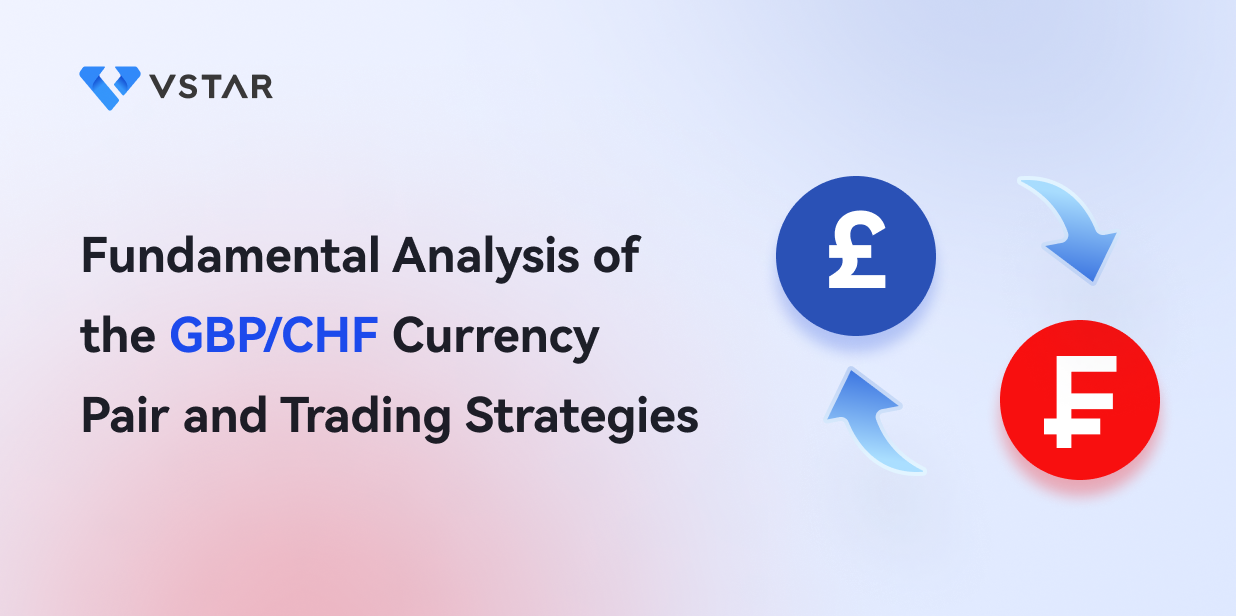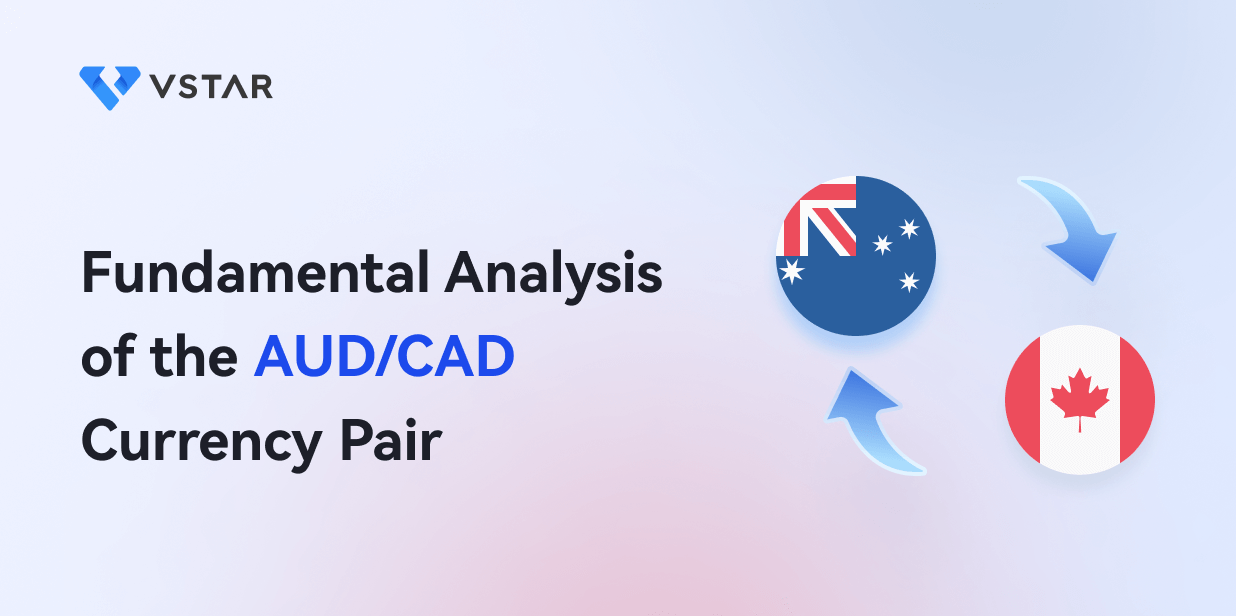Introduction
The GBP/CHF currency pair represents the exchange rate of the British Pound Sterling (GBP) and the Swiss Franc (CHF) (CHF). It shows how many Swiss Francs are required to buy one British Pound. Traders and investors commonly use this pair in the forex market to speculate on the relative strength of the UK economy versus that of Switzerland. Because the GBP is the base currency and the CHF is the quote currency, rising GBP/CHF rates indicate that the British Pound is strengthening against the Swiss Franc and vice versa.
The GBP/CHF currency pair can be considered a risk barometer for traders due to the unique characteristics of the two currencies involved and the economies they represent. The British Pound (GBP) and the Swiss Franc (CHF) are influenced by different factors, allowing the pair to reflect shifts in risk sentiment and global economic conditions.
Safe-haven status of CHF: The Swiss Franc is widely regarded as a safe-haven currency due to Switzerland's political and economic stability, low inflation, and strong banking system. During global economic uncertainty or heightened geopolitical tensions, investors often flock to safe-haven assets like the Swiss Franc, leading to its appreciation against riskier currencies like the GBP.
Riskier profile of GBP: The British Pound is often considered a riskier currency compared to the Swiss Franc, as the UK economy is more susceptible to economic fluctuations and geopolitical events, such as Brexit. When risk sentiment is positive and investors have a higher risk appetite, the GBP may appreciate against the CHF, reflecting increased confidence in the UK's economic prospects.
Macroeconomic Overview - United Kingdom

The United Kingdom's economy is one of the largest and most diversified in the world. To understand its overall health and performance, it is essential to review several key economic indicators.
GDP and Unemployment Rate
Gross Domestic Product (GDP) serves as a measure of a country's economic output and growth. The UK has experienced moderate GDP growth in recent years, recovering from the downturn caused by the COVID-19 pandemic. The unemployment rate has steadily decreased as the economy rebounds, creating new job opportunities across various sectors.
Inflation Rates
Inflation is another critical indicator of economic health, reflecting the rate at which the general level of prices for goods and services is rising. The UK has seen fluctuating inflation rates in recent years, with the Bank of England (BoE) closely monitoring price stability to maintain its target inflation rate.

Business and Consumer Confidence
Business and consumer confidence indices provide insights into the sentiment and expectations of companies and households. Both indices have shown improvement as the UK's economic prospects brighten, signaling increased optimism and willingness to spend and invest.
Monetary Policy
Monetary policy plays a vital role in shaping the UK's economic landscape, with the Bank of England (BoE) responsible for implementing these policies.
Bank of England's Monetary Policy
The BoE's primary objective is to maintain price stability and support the government's economic objectives, including growth and employment. It achieves this by adjusting interest rates, engaging in quantitative easing, and using other monetary policy tools.
Interest Rate Expectations
Interest rate expectations are crucial for understanding the direction of monetary policy. The BoE's decisions regarding interest rates can impact borrowing costs, investment, consumption, and inflation, thereby influencing the overall economic climate.
Political Climate
The political environment in the UK plays a significant role in shaping its economy.

Economic Policies of the Government
The government's economic policies, including fiscal measures such as taxation and public spending, can significantly influence the country's economic performance. Policies promoting growth, investment, and job creation can contribute to a stable and robust economy.
Brexit
Brexit, the United Kingdom's decision to leave the European Union, has had a profound impact on the country's economic landscape. While the immediate uncertainty has subsided, ongoing negotiations regarding trade agreements and regulatory alignment influence the economy, businesses, and consumer sentiment.
In conclusion, a comprehensive understanding of the United Kingdom's macroeconomic landscape requires an analysis of key economic indicators, monetary policy, and the political climate. Investors and policymakers can make more informed decisions regarding the country's economic prospects and future growth by closely examining these factors.
Macroeconomic Overview - Switzerland
Switzerland is renowned for its economic stability, strong banking system, and high living standards. We will examine key economic indicators, monetary policy, and the political climate to gain a comprehensive understanding of its macroeconomic landscape.

Economic Indicators Review
Any fundamental analysis of a financial market needs to review economic indicators. This is true with the Swiss franc, just as with any other asset.
GDP and Unemployment Rate
Switzerland boasts a highly developed and diverse economy with consistently strong GDP growth. The country's unemployment rate remains low compared to other developed economies, highlighting its robust labor market.
Inflation Rates
Switzerland has historically maintained low inflation rates, which contribute to the country's economic stability. The Swiss National Bank (SNB) closely monitors inflation to ensure price stability and support sustainable economic growth.
Business and Consumer Confidence
Both business and consumer confidence indices in Switzerland remain strong due to the country's stable economy and favorable business environment. These indices reflect the overall sentiment and expectations of businesses and households.
Monetary Policy
Monetary policy in Switzerland is controlled by the central bank, the Swiss National Bank (SNB), and can have massive implications regarding where the Franc trades at.

Swiss National Bank's Monetary Policy
The Swiss National Bank (SNB) is responsible for implementing monetary policy in Switzerland, with the primary goal of maintaining price stability while considering economic developments. The SNB uses various monetary policy tools, such as interest rates and foreign exchange interventions, to achieve its objectives.
Interest Rate Expectations
Interest rate expectations play a crucial role in shaping Switzerland's economic landscape. The SNB's decisions on interest rates can impact borrowing costs, investments, consumption, and inflation, thereby influencing overall economic conditions.
Political Climate
The political environment in Switzerland, both from a federal level and in the cantons, will play a significant role in shaping its economy.
Economic Policies of the Government
Switzerland's government implements economic policies that promote stability, growth, and a competitive business environment. Fiscal measures such as taxation and public spending are carefully managed to support the country's economic performance.

Impact of Global Trade Disputes on Switzerland
Switzerland is exposed to global trade disputes and economic fluctuations as a small and open economy. However, the country's well-diversified economy and strong trade relations help mitigate the impact of global trade tensions on its economic performance.
Ultimately, understanding Switzerland's macroeconomic landscape requires an in-depth examination of its key economic indicators, monetary policy, and political climate. Investors and policymakers can make more informed decisions about the nation's economic prospects and future growth by analyzing these factors.
Analysis of the GBP/CHF Currency Pair
The GBP/CHF currency pair reflects the exchange rate between the British Pound Sterling (GBP) and the Swiss Franc (CHF). Understanding the various factors influencing the pair is crucial for traders and investors. This analysis will examine relevant economic indicators, factors supporting bullish or bearish trends, and potential risks to the currency pair.
Relevant Economic Indicators
Correlation between the UK and Swiss economies
The GBP/CHF currency pair is influenced by the correlation between the UK and Swiss economies. A strong correlation between the two economies suggests that their economic indicators, such as GDP growth and inflation rates, move in the same direction, thereby affecting the currency pair.
At the same time, you could argue that at times it is the fact that there is the propensity for traders to run towards Switzerland in times of trouble that can exploit the differences between the two economies.
Impact of GDP growth, inflation rates, and interest rates on the currency pair
GDP growth, inflation rates, and interest rates play crucial roles in determining the exchange rate of the GBP/CHF pair. Changes in these economic indicators can affect the relative strength of the currencies, thereby influencing the pair's exchange rate.
Factors Supporting a Bullish or Bearish Stance
There is a multitude of factors that can influence a bullish or bearish stance in the GBP/CHF, including:
Brexit and its Impact on the currency pair
Brexit has significantly impacted the British Pound, resulting in fluctuations in the GBP/CHF currency pair. Brexit negotiations' uncertainty and potential economic consequences have influenced market sentiment and the Pound's value.
Impact of Bank of England's interest rate policy on the currency pair
The Bank of England's interest rate policy affects the GBP/CHF pair as it influences the cost of borrowing and the relative attractiveness of the British Pound. For instance, the Bank of England's decision to raise interest rates from 0.10% in December 2021 to 2.25% in September 2022 has had implications for the currency pair.
Impact of Swiss National Bank's monetary policy on the currency pair
Swiss National Bank's (SNB) monetary policy decisions can also influence the GBP/CHF pair, as they affect the strength of the Swiss Franc. The SNB's primary objective is to maintain price stability while considering economic developments, which can affect the currency pair.
Potential Risks to the Currency Pair

There are potential risks in any trading market, and the GBP/CHF pair isn't going to be any different.
Sudden changes in global trade policies
Sudden shifts in global trade policies can pose risks to the GBP/CHF currency pair. Changes in trade relations or protectionist measures can impact both the UK and Swiss economies, thereby affecting the exchange rate of the pair.
Unexpected changes in UK or Swiss monetary policies
Unexpected changes in monetary policies by the Bank of England or the Swiss National Bank can create volatility in the GBP/CHF pair. Traders and investors should monitor the central bank's policy decisions and their potential implications for the currency pair.
Political tensions between the UK and Switzerland
Political tensions or disagreements between the UK and Switzerland can introduce uncertainty and volatility in the GBP/CHF currency pair. Such tensions can impact trade, investment, and economic relations, leading to fluctuations in the exchange rate.
Understanding the various factors influencing the GBP/CHF currency pair is essential for informed decision-making in trading and investing. By analyzing the relevant economic indicators, considering bullish or bearish trends, and assessing potential risks, traders and investors can better navigate the complexities of the GBP/CHF market.
Trading Strategies for GBP/CHF
The GBP/CHF currency pair is important for many traders and investors. This article will explore various trading strategies for this pair, including technical analysis, risk management, and news trading.
Technical Analysis
Technical analysis is the practice of looking at charts for historical patterns that can show where buyers are sellers are more likely to enter the markets, allowing the traders to attempt to predict where prices in an asset will go.
Identifying trends and patterns
Identifying trends and patterns is crucial for GBP/CHF trading. Technical analysis helps traders recognize potential price movements and make informed decisions based on historical price data. By examining price charts, traders can identify trendlines, support and resistance levels, and other patterns to gain insights into future market movements.
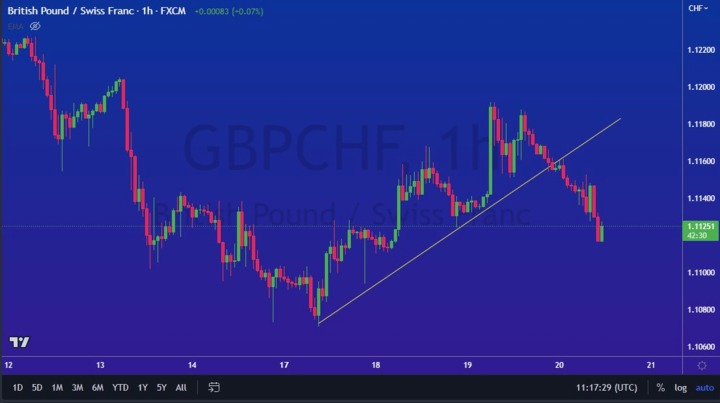
A trendline is drawn on this chart. You can see the buyers were in control for some time, offering plenty of buying opportunities. However, the trendline eventually broke. This is a sign that it's time to sell now.
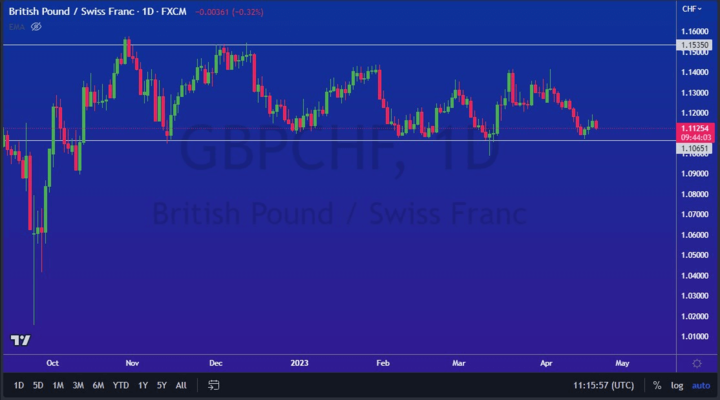
Support and resistance lines are clearly shown on this daily chart of GBP/CHF. Buying and selling at these levels will have been a good set up.
Use of indicators such as moving averages and MACD
Technical indicators, such as moving averages and the Moving Average Convergence Divergence (MACD), can help traders decide. Moving averages help smooth out price data to identify trends, while the MACD measures the momentum and strength of a trend. These indicators can provide valuable information on potential entry and exit points for GBP/CHF trades.
The most common way the MACD is used is when the moving averages in the indicator cross the zero line, a trade is taken in the same direction. For example, if the lines cross above the zero line of the indicator, it is to be bought. The opposite is also true.
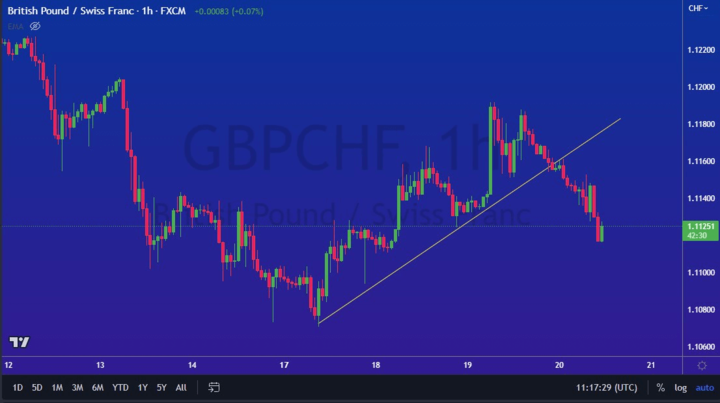
GBP/CHF w/ the MACD indicator
Risk Management
One of the most important facets of trading is going to be risk management. Professional traders will tell you that you are primarily a “risk manager” and secondarily a trader.
Setting Stop-Loss and Take-Profit levels
Effective risk management is essential for successful GBP/CHF trading. By setting stop-loss and take-profit levels, traders can limit their losses and lock in profits. Stop-loss orders help minimize losses by closing a trade when the market moves against it, while take-profit orders close a trade once a predetermined profit level is reached.
Determining position size based on risk tolerance
Determining the appropriate position size based on risk tolerance is another crucial aspect of risk management. By adjusting the size of their positions, traders can control the risk they are willing to take on each trade. This helps maintain a balanced trading portfolio and prevents overexposure to any single currency pair or market.
News Trading

Following economic events and data releases
Economic events and data releases can significantly impact the GBP/CHF currency pair. By staying informed of these events, traders can anticipate potential market reactions and position themselves accordingly. Key economic events include interest rate decisions, GDP growth, inflation data, and the UK and Switzerland political developments.
Trading based on market reactions to news
News trading involves taking advantage of market reactions to economic events and data releases. By analyzing how the market reacts to news, traders can identify potential opportunities for GBP/CHF trades. This strategy requires a deep understanding of the underlying fundamentals and an ability to respond quickly to market fluctuations.
Developing a robust trading strategy for the GBP/CHF currency pair requires a combination of technical analysis, risk management, and news trading. By employing these approaches, traders can increase their chances of success in the forex market and capitalize on opportunities presented by the GBP/CHF currency pair.
Trade GBP/CHF at VSTAR
VSTAR allows traders to access the currency markets and trade pairs, such as the GBP/CHF pair. VSTAR offers the mobile enhanced trading experience App with tight spreads and plenty of educational materials. VSTAR is also highly regulated and licensed, allowing you to know your deposit is safe.
Conclusion
In conclusion, understanding the GBP/CHF currency pair requires a comprehensive analysis of various factors influencing its performance, such as relevant economic indicators, potential risks, and trading strategies. By examining these aspects, traders and investors can make informed decisions and develop effective strategies for navigating the forex market. Furthermore, adopting a well-rounded approach incorporating technical analysis, risk management, and news trading can increase the likelihood of success in trading the GBP/CHF pair. Staying informed about the latest economic developments and continuously refining trading strategies will help individuals capitalize on opportunities and navigate the ever-changing landscape of the forex market.
Remember that the pair tends to be very volatile, so it is crucial to use proper position sizing for your account. VSTAR allows you to customize trade sizes, making the ability to trade currencies within the reach of almost everyone.
